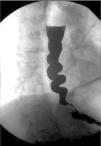A 75-year-old man was referred due to dysphagia with each meal, weight loss of 5 kg and non-acidic regurgitation over the past 20 years (Eckardt score of 7/12). On upper gastrointestinal endoscopy, the oesophagus showed a striking spiral morphology with gastro-oesophageal junction spasticity (Fig. 1). An oesophagogram revealed a “corkscrew” image (Fig. 2). High-resolution manometry (HRM) showed elevated mean integrated relaxation pressure (46 mmHg; normal <15) and aperistalsis with pan-pressurisation every time the patient swallowed, consistent with type 2 achalasia (Fig. 3).1 Peroral endoscopic myotomy (POEM) was performed, revealing posterior myotomy measuring 12 cm in the oesophageal branch and 2 cm in the gastric branch, in 120 min, with no adverse events, although the procedure was technically complex due to the tortuosity and spasticity of the patient's oesophagus. Three months later, the patient showed significant improvement of both his signs and symptoms (Eckardt score of 1/12) and his oesophagogram and HRM findings.
High-resolution manometry (HRM). Elevated mean integrated relaxation pressure (46 mmHg; normal <15) and aperistalsis with pan-pressurisation every time the patient swallowed, suggestive of type 2 achalasia. In addition, overlapping component of non-premature spastic contraction in the distal segment and intermittent oesophageal shortening.
Corkscrew oesophagus is a radiological term that alludes to the shape of the barium column in the distal oesophagus, classically associated with distal oesophageal spasm and, rarely, with achalasia.2 POEM is a treatment option that requires suitable prior planning given the morphological and functional characteristics of the oesophagus.
FundingNo funding was received for this study.
Conflicts of interestThe authors declare that they have no conflicts of interest.
Please cite this article as: Sánchez-Aldehuelo R, Rodríguez de Santiago E, Teruel Sánchez-Vegazo C. Acalasia y esófago «en sacacorchos»: una presentación atípica, un desafío terapéutico. Gastroenterol Hepatol. 2022;45:141–143.












